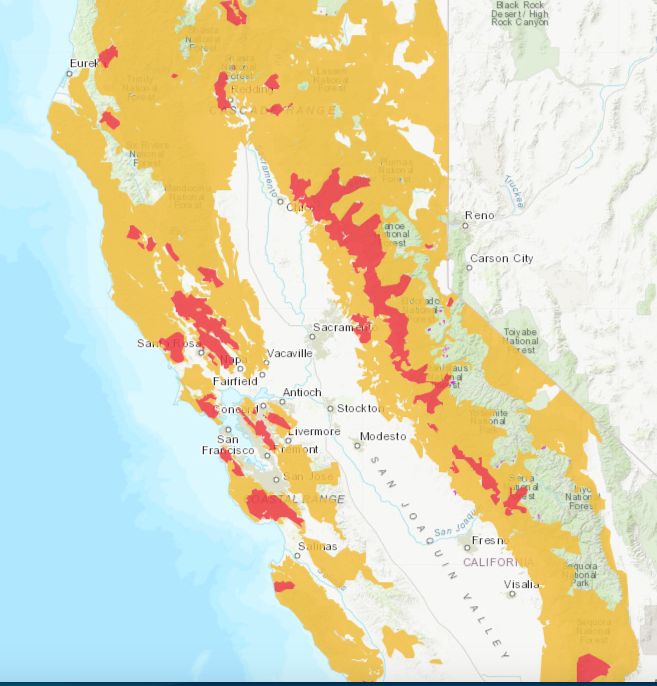California has passed its first-ever subsidy aimed specifically at bringing more distributed solar and energy storage to people at highest risk of having their power shut off by utilities trying to prevent wildfires.
The California Public Utilities Commission approved changes (PDF) late last week to the Self-Generation Incentive Program, the state’s premier behind-the-meter battery incentive program. Among them is a $100 million carve-out for vulnerable households and critical services in Tier 2 and Tier 3 “high fire threat districts,” offering incentives that could pay for nearly all of a typical residential battery installation, according to the CPUC analysis.
This supercharged incentive is aimed specifically at people at the highest risk of being hurt if, or when, grid power is cut off for hours or even days at a time under the state’s heightened wildfire prevention regime. While utilities have been sparing in their use of this new "public safety power shutoff" authority so far this summer, they are largely at the mercy of the weather to determine how often they’ll be forced to use it in the future, or how many customers might be affected.

Climate change is driving hotter and drier conditions, putting large swaths of the state at high risk of catastrophic wildfires, including those caused by utility power lines. Pacific Gas & Electric’s bankruptcy was driven by its liabilities from wildfires in 2017 and 2018 caused by its power lines, and Southern California Edison and San Diego Gas & Electric have faced credit downgrades and the threat of insolvency if they’re hit with blame for a major fire.
State regulators and lawmakers have responded to the crisis with steps including a $21 billion wildfire fund for utilities, as well as mandates to invest billions in grid repairs, tree-trimming, weather forecasting, and other wildfire prevention efforts. Thursday’s decision marks the first time the CPUC has approved one of the several proposals from utilities and distributed energy resources vendors such as Sunrun to put market-based incentives to work on the same task.
The funding will come from SGIP’s equity budget, a set-aside for low-income, medically compromised or otherwise disadvantaged residents. Utilities and solar-storage vendors have struggled to enroll many of these customers in what’s still an expensive solar-storage proposition, leaving large portions of the equity budget unspent.
The regulator's decision addresses many of challenges on this front, such as opening SGIP funding to specific Central Valley disadvantaged communities and participants in existing multi-family housing solar programs. It also boosts the current cap of 50 cents per watt-hour for battery installations, already higher than the mainstream incentive, to 85 cents per watt-hour.
Higher premium
The $100 million carve-out would apply an even higher premium to systems meant to bolster grid resilience against wildfires, up to $1 per watt-hour. “This will address the primary barrier to participation in SGIP by equity budget-eligible customers, particularly residential customers, which is lack of access to financing or capital,” the CPUC noted.
Indeed, at $1 per watt-hour, SGIP pays for $13,200, or 98 percent, of the cost of the typical Tesla Powerwall residential battery system used as the CPUC’s reference case, compared to $6,600 or 50 percent at 50 cents per watt-hour, or $11,200, or 83 percent, at 85 cents per watt-hour.
“Party comments on the proposed decision persuaded us that the risk of setting the incentive levels too low for the new equity resiliency budget and the equity budget, leading again to no or very low participation in these budgets, outweighs the risk that developers will inflate costs,” the CPUC wrote.
Not everyone living in Tier 2 or 3 areas will be eligible for this funding, only “SGIP critical resiliency needs” customers. With a few exceptions, this includes people who meet the equity budget’s low-income and disadvantaged criteria, or are “medical baseline” customers who have notified their utility of a “serious illness or condition that could become life-threatening if electricity is disconnected.”
Critical services and critical infrastructure in Tier 2 and 3 districts can also apply for the carve-out, although CPUC’s decision makes clear it will prioritize “only the most critical facilities and infrastructure and those with the least ability to fund a storage system.”
The CPUC also set up new rules for critical resilience customers, who are meant to use their batteries to “island,” or run disconnected, from the grid, to deal with the fact that the SGIP program wasn’t designed for islanding. These include requirements to have the system inspected by the local utility or another authority with jurisdiction over its interconnection, and to file data on how long it can operate in island mode under different conditions.
Beyond the $100 million wildfire carve-out, the decision makes some important changes to SGIP’s approach to low-income, disadvantaged and multifamily housing, the CPUC’s press release noted. Those include granting eligibility to participants in the Single Family Affordable Solar Homes (SASH) program, the SASH for Disadvantaged Communities program, the Solar on Multifamily Affordable Housing program, and the Multifamily Affordable Solar Housing program.
The CPUC also approved $4 million for heat pump water incentives and $10 million for SGIP storage incentives to support pilot projects in 11 San Joaquin Valley disadvantaged communities.




